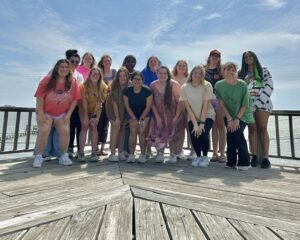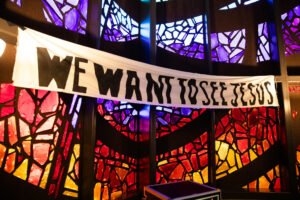Tradition Spotlight: Beanie Capping
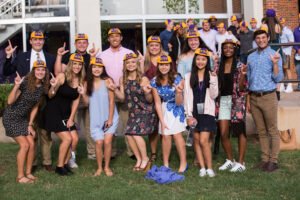
(ABILENE, Texas)–Alumni of Hardin-Simmons University know that few things on the forty acres stand as strong as the school’s overwhelming love for tradition. One such tradition is the freshman beanie, a continuing method of marking new students and making it easier for upperclassmen to introduce themselves and share a few words of sage advice.
Beanie Capping
The first mention of freshman beanies at HSU is in a 1909 edition of The Corral, an early newsletter from the university, and each incoming class of the past century participated in the annual beanie capping. At the end of STAMPEDE, HSU’s orientation week, first-year students stand on the Behrens Auditorium stage while their STAMPEDE Wranglers place purple and gold caps on their heads while whispering various nonsensical phrases.
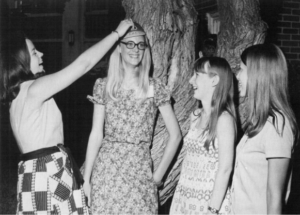
Several freshmen women laugh about how to properly wear a beanie at a lawn party thrown by Dr. and Mrs. Skiles in 1971.
Once all first-year students receive their caps, they hear the story of Freddy Freshman, a fictional college first-year student who refuses to take part in any silly traditions or activities. Freddy struggles to make friends because he hides in his residence hall instead of going to campus events.
At the end of his first semester, Freddy drops out of HSU because he hasn’t taken the opportunity to meet people and get plugged in on campus. The freshman class is warned, “Don’t be like Freddy Freshman,” and are encouraged to wear their beanie with pride and to get involved as soon as possible.
The tradition is as treasured as is it odd on the Forty Acres, and it provides common ground for all students of Hardin-Simmons University. After the ceremony, freshmen meander into the Mabee Gymnasium, where alumni wait to serve the students homemade ice cream and sign the caps of the incoming class.
The HSU Beanie
Though beanies are made in HSU purple and gold today, the notable headwear was green and yellow until 1959. The HSU insignia on the front is a newer addition, as well, as the front of the hats once included a stitched-on applique of the students’ graduation year. The switch to a uniform beanie-front came about in the early 1960s.
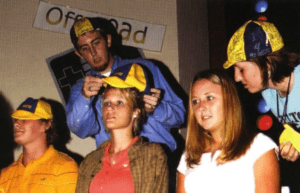
A group of first-year students receive their beanies during the beanie capping ceremony in 2005.
Throughout the past century, the look of the beanie may have changed, but the original purpose of the headwear remains. The bright green and yellow caps of the early 20th century marked freshman, jovially called “fish,” “slime,” or conjointly “slimy fish,” so that upperclassmen could easily find and greet new students easily.
A second possible reason behind the green “Slime Caps” at a purple and gold school hides in an old edition of The Corral, which infers that President Sandefer lacked trust in his students if he could not see them. The article states that the brightly colored headgear allowed President Sandefer to monitor his new students both in and out of class.
Treasured Tradition
Today, wearing a freshman beanie is strongly recommended, but optional. Over the first half of the 20th century, first-year students had to wear the headwear each day until the annual All-School Picnic and were punished by upperclassmen for not wearing their caps. Students often were made to stand in a large metal jail cell on Anderson lawn or dumped in the old fountain near Moody Student Center or the Reflection Pond.
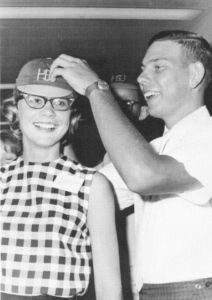
A junior helps a freshman adjust her beanie in 1964.
Although the punishments were carried out in good fun, and many alumni cherish the memory of getting wet for forgetting their beanies, the penalties slowed as the years progressed. Sue to several catastrophic events of the early to mid-1900s, such as World Wars I and II, HSU’s student body diversified and included more mature groups of non-traditional students who held different priorities than their younger first-year peers.
In Spring 1954, the student council presented the beanie tradition to the floor during one of their meetings. The council voted to make wearing beanies optional the following fall semester, but they still encouraged freshmen to wear their caps for the sake of school spirit.

